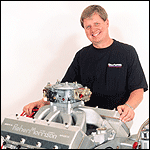 By David Reher, Reher-Morrison Racing Engines
By David Reher, Reher-Morrison Racing Engines
I come from a family of teachers, so I suppose it was inevitable that I would end up standing in front of a classroom. My father lectured on economics, but my specialty is racing engines. I thought I knew that subject well – until my students asked questions that I couldn’t answer!
This year we’ve hosted a series of Reher-Morrison Racing Engine Schools at our shop in Arlington, Texas. It’s rare to have a weekend when Bruce Allen and I aren’t racing or testing our Pro Stock Firebird, but I’ve found myself looking forward to the classroom sessions. A recent group of students who came for a two-day class was really into internal combustion, and their enthusiasm renewed my interest in parts and pieces that I’ve worked with for years.
During a Q&A session at the end of the day, I found myself asking more questions than giving answers. When a student asked me about the best intake runner volume or the right camshaft profile for a particular engine, my reply usually began with the words, “Well, it all depends . . .”
Later I realized that there are no simple answers in racing. Why do we use heads with360cc intake runners on a 522ci Super Series bracket big-block and heads with 500cc runners on our 500ci Pro Stock motors? The two engines have similar displacements, but their operating ranges, power curves, construction costs, and maintenance requirements are radically different. Those differences affect virtually every part of the engine combination, from the oil system to the carburetor.
Mathematicians and physicists have developed a way to look at complex systems called the Chaos Theory. The Chaos Theory states that even tiny changes in input in a complex system can produce huge differences in the final results. The notion that chaos is a fundamental force in the way the world operates explains phenomena ranging from global weather patterns and stock market prices to the random dripping of a leaky faucet.
I’ll cite the example of the Butterfly Effect, and then I’ll bring this column back to drag racing. Suppose a butterfly in China flaps its wings, creating a small eddy in the air. Over time, that eddy may develop into a tornado that levels a city in Indonesia. Or the butterfly’s wings may have disrupted an air current that otherwise would have grown into a hurricane in Hawaii.
The fact is that global weather is an amazingly complex system. The world’s largest weather computer can perform 400 million calculations every minute, yet its forecasts beyond two or three days are consistently incorrect. Chaos Theory confirms that the predictability of complex systems is extremely limited.
To return to the subject of drag racing, you might substitute valve springs for butterfly wings as an example of how a small change can produce dramatically different results. For years valve springs were a limiting factor in engine development; racers had to put up with breakage, loss of pressure, and frequent replacement. The spring manufacturers and suppliers have made great strides in metallurgy, and the new generation of springs is strong and reliable.
As a result of this relatively small advance in valve springs, the cam designers can now use more aggressive “square” profiles that open the valves faster and harder. As the area under the lift curve expands, you can rev the engine higher, which typically requires bigger ports and a larger manifold. Now you need new carburetor calibrations, and the change in the power curve demands a different clutch setup, new transmission ratios, and perhaps a rearend gear change. The suspension, shock absorbers, and perhaps the chassis itself have to be reworked. In effect, a seemingly insignificant change ripples through the complex system of the entire race car, producing a radically different combination at the end.
Consider the impact of shaft rocker arms. Years ago the rocker arms were a real hindrance to cylinder head development. We couldn’t relocate the ports because there was no way to put the pushrods where they needed to be with stud-mounted rocker arms. Dan Jesel told me, “You put the port where you want it and I’ll figure out how to put a rocker arm on it.” That was one of the truest statements I’ve heard in racing, because Jesel did exactly that. His shaft-mounted rockers opened new avenues to performance. Now the factories produce blocks with blank lifter bores that give us even more latitude in valvetrain and cylinder head designs.
The fact that every part in a race car is interrelated with every other part was the root of my difficulty in providing precise answers to my students’ questions. Building a racing engine is not like building a house where you know how long every joist and stud should be. Either they’re the right lengths or they’re not. But who can say with authority what the correct port volume or runner length should be for a particular engine?
Questions about engines are difficult to answer because you have to know all of the parameters. The motors we build are combinations of parts that we have carefully selected through constant R&D. If you change the carburetor or cam, the performance usually suffers because the parts no longer work together in harmony. Perhaps you make a change that does produce more horsepower – do you need to upgrade the connecting rods and wrist pins to withstand the increase in cylinder pressure and higher engine speeds?
The Chaos Theory definitely applies to racing engines. A small change can make a huge difference. When I first started racing, we’d routinely make wholesale changes in engine combinations. Today we’re down to the fine details. That’s the lesson this teacher has learned in the school of racing.
